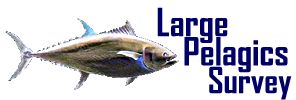
QuanTech's Fisheries Research Group conducts the Large Pelagics Survey (LPS) for the US Department of Commerce, National Oceanic and Atmospheric Administration, National Marine Fisheries Service, NOAA Fisheries, Office of Science and Technology.
Since 1992, the National Marine Fisheries Service has administered the LPS to collect information about the recreational fishery directed at large pelagic species (e.g., tunas, billfishes, swordfish, sharks, wahoo, dolphinfish, and amberjack) in the offshore waters from Maine through Virginia. Participation in this survey is greatly appreciated and is an important step toward fulfilling mandatory reporting requirements as an Highly Migratory Species (HMS) permit holder.
The authority to collect LPS data comes from the Atlantic Tunas Convention Act and the Magnuson-Stevens Fishery Conservation and Management Act. The collection of catch and effort information on large pelagics also fulfills U.S. obligations to the International Commission for the Conservation of Atlantic Tunas (ICCAT).
The LPS includes two independent, yet complementary, surveys which provide the effort and average catch per trip estimates needed to estimate total catch by species. The Large Pelagics Intercept Survey (LPIS) is a dockside survey of fishing access sites, primarily designed to collect catch data from private and charterboat captains who have just completed fishing trips directed at large pelagic species. LPIS data are used to estimate the average recreational catch per large pelagic boat trip by species.
The LPIS involves intensive field interviewing in the coastal areas from Virginia through Maine.
In Maine, the LPIS is conducted by State personnel. QuanTech conducts the LPIS from Virginia through New Hampshire. The LPIS involves:
- Revision and refinement of all field survey instruments and data collection procedures in cooperation with NOAA Fisheries;
- Creation and maintenance of a sampling frame of large pelagic fishing access sites;
- Detailed training of field interviewers in the methodology and procedures to be used in the field interviewing process; and,
- Procedures to verify and enhance the quality of the data collected using comprehensive field management techniques, and in-house SAS data checking programs.
To meet the requirement of delivery of LPIS data files to NOAA Fisheries, data collected in the field is sent within 24 hours of interviewing assignment completion and checked for completeness and consistency. Optical Character Recognition (OCR) software is used to capture data from field forms. During data capture each entry on the form is verified by an OCR operator. A SAS dataset meeting NOAA Fisheries' specifications is prepared and delivered to NOAA Fisheries each month.
The Private vessel portion of the Large Pelagics Telephone Survey (LPTS) is conducted from QuanTech Headquarters in Rockville, Maryland using a custom-designed Computer Assisted Telephone Interviewing system. The LPTS collects data used to estimate the total number of boat trips on which anglers fished with rod and reel or handline for large pelagic species. For-hire boats are covered by a weekly survey, and private boats are covered by a biweekly survey. The Charter/Headboat LPTS is a survey of charter and headboat fishing for HMS. The Private LPTS covers both commercial fishing by vessels with General category HMS permits, and true recreational fishing by vessels with Angling category HMS permits.
